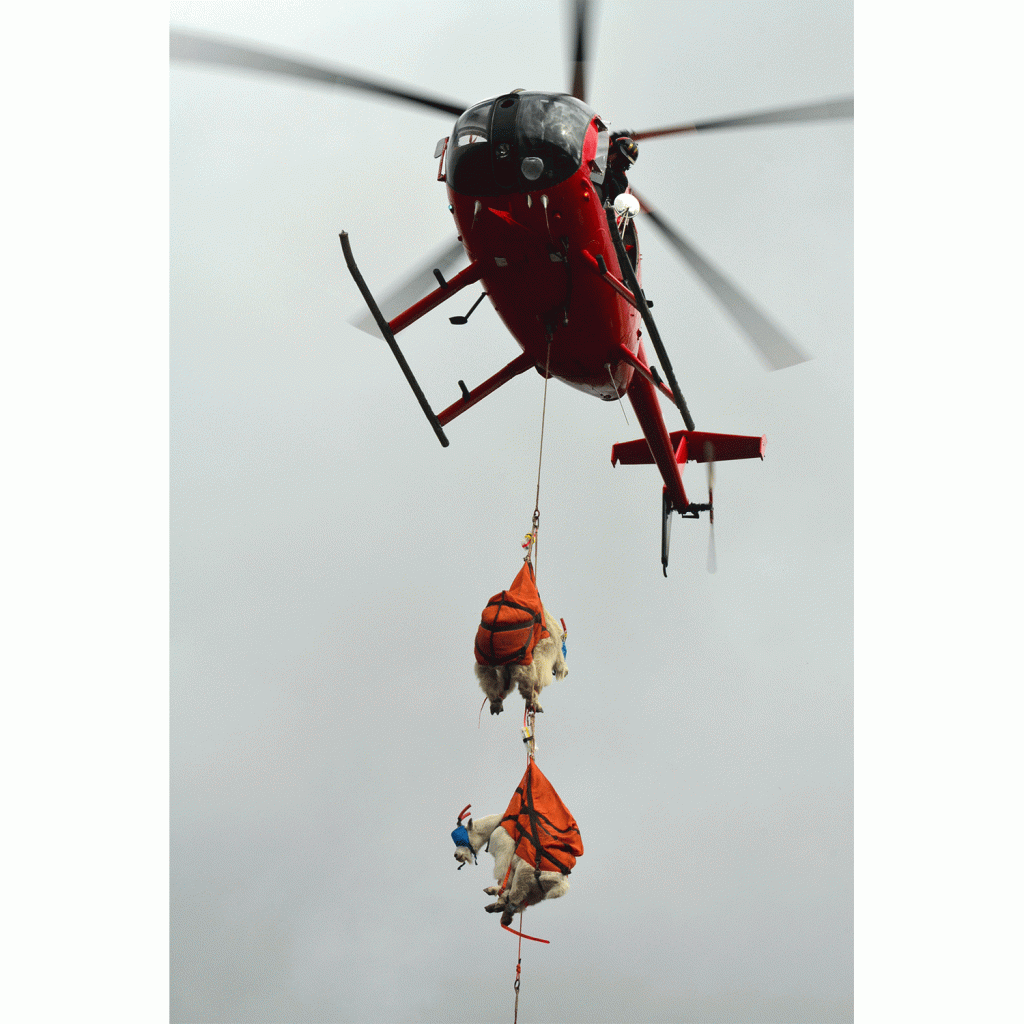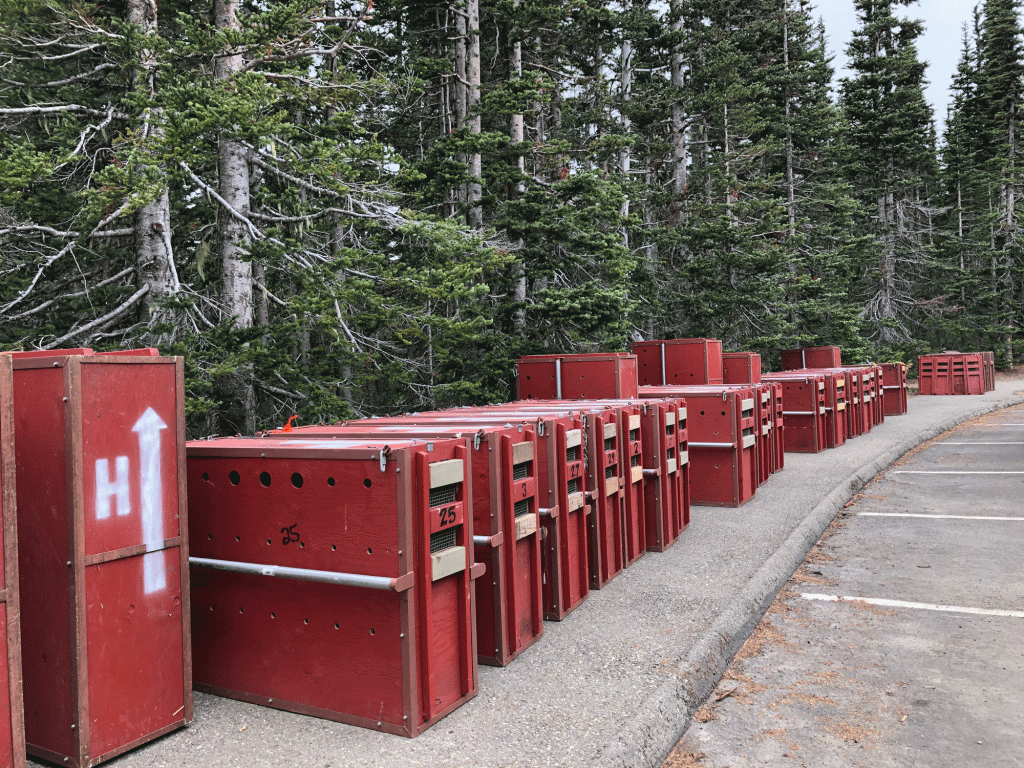The second phase of a plan to remove all the mountain goats from the Olympic Peninsula begins this month. The operation will result in two temporary closures that will impact Olympic National Park and Olympic National Forest: the first from July 8–19 and the second Aug. 19–30.
In September of last year, Washington state and federal agencies, with the support of local tribes, began to execute a plan addressing a decades-long goal to move the mountain goats—which had grown to an overall population of 725—from the Olympic Peninsula to their native habitat in the North Cascades. The goats, non-native to the peninsula, were having a negative impact on the environment: an invasive species trampling vegetation, damaging resources and competing with other native animals, like the marmot, for food. Additionally, some goats have become habituated to people. Mountain goats were originally introduced to the peninsula in the 1920s to serve hunting interests, and the population has increased ever since. In the Cascades, however, the goat population has diminished as a result of overhunting.
“We need goats in the Cascades. We don’t need them in the Olympics,” says Rob Smith, Northwest regional director for the National Parks Conservation Association. “It’s essentially two restoration projects in one. And while it’s a disruption in the short term, it’s the right thing to do in the long term.”
The relocation is a joint effort between the National Park Service, the Washington Department of Fish and Wildlife, and the U.S. Forest Service, and is part of a three-to-five-year plan that consists of two 12-day capture periods per season. The affected areas are in the northern part of Olympic National Park, where periodic trail and camping closures will restrict visitor access to certain places, including Hurricane Ridge, Lake of the Angels, the Elwha Valley, and Seven Lakes Basin. The August closure will impact areas around Mount Ellinor. Visitors should seek out specific information about closures before heading to the peninsula.

The goats are fitted with an eye mask and loaded into a specially made sling, then flown to refrigerated trucks headed for the North Cascades. (Photo Courtesy: National Park Service)
During the capture windows the mountain goats embark on a multistep journey to their new home: crews from Leading Edge Aviation fire a net gun (with a weighted net) or a dart gun (with an opioid) from a helicopter, then the goats are loaded into a specially made sling and fitted with an eye mask before being flown to eastbound refrigerated trucks. Finally, the goats take another helicopter flight into the North Cascades backcountry, where conditions are right: high elevations that have current goat populations or have had them in the past.
One week into phase two, 23 goats have been removed from the Olympics, where more than 95 percent of the goat population lives in “remote, rugged terrain that is extremely steep and far away from roads and trails,” according to the Park Service. To capture and transport the goats, “there is simply no other way” than by using helicopters. Eventually, goats that can’t be captured in this way will be shot.
“To maximize success, goats are then airlifted directly to alpine habitats that have been selected for appropriate characteristics. These areas are generally not accessible by road,” says Olympic National Park spokeswoman Penny Wagner.
Last fall, the National Park Service says 115 mountain goats were captured in the Olympics, but some goats died during capture or transport, and orphaned kids were taken to local zoos. One hundred were actually transferred to the Cascades, and 98 were released (two died in transit). New for this year is a change in opioid, from Carfentanil to Thiafentanil, which officials anticipate will reduce death during capture.

A row of crates used to safely release the goats to their new home in the North Cascades. (Photo Courtesy: National Park Service)
An estimated 65 to 70 percent of the goats survived the winter, according to a report by Rich Harris, the state Department of Fish and Wildlife biologist leading the agency’s relocation effort. Harris’ report showed that the goats—most were fitted with GPS collars before being transferred—moved around a fair bit before they “hunkered down for the winter” but are now moving up into the alpine. Harris told The Seattle Times that the rate is “within the bounds” he expected, adding that a rough February and a winter of heavy snow can make it difficult for animals to find food. According to Wagner, the project is going as planned and administrators are pleased with the relocation efforts thus far.
Over the next two months, the Department of Fish and Wildlife plans to release the goats captured in this second phase at six different alpine sites in the North Cascades: the Chikamin area, Preacher Mountain, Hardscrabble Ridge, two spots near mountain peaks south of Darrington, and near Mount Index.
The project will continue for seasons to come, and the next scheduled closures will likely take place in the summer of 2020. Visitors to the park should take note of these closures, adjust their plans accordingly, and be willing to put up with some helicopter noise if they’re in the vicinity.
According to Wagner, success for the program is twofold: “To translocate as many mountain goats from the Olympic Peninsula to the Cascades as possible, which is estimated to be 325–375” total goats transported for the entirety of the project. “And then ultimately … to reach a zero population level of mountain goats in the park and adjacent Olympic National Forest lands.”
Tips for mountain goat encounters
In general, mountain goats tend to keep their distance, but “goats approach people because we’re salty,” says Smith. “There are very few natural salt sources in the Olympics. There are many, many more natural salt licks in the Cascades, which would make them less inclined to approach humans.” That said, here are some tips from the park service and Forest Service for what to do if you encounter a mountain goat.
- Be sure to urinate on a rock, bare soil or snow at least 100 feet from the trail.
- If you see a goat while you’re out you should keep your distance from them as well, staying about 50 yards back.
- If the goat approaches you, slowly move away to maintain that distance. If they continue to approach, chase them off by yelling, waving clothes, and throwing rocks.
- If you do have an encounter with a goat at closer than 50 yards, make sure to report it to a ranger station.
[Read the Journal’s previous coverage: What the Removal of Mountain Goats from the Olympics Tells Us About Wildlife in National Parks]
